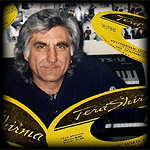About/Contact
Apr 01 2012
1 Comment
Soundtrack
The Wiz [[Original Soundtrack) [[1978)
“There’s nothing here but the fear of will I try? And can I stare it in the eye?”
As of 1978, Diana Ross’s film career had been brief but hugely successful, and had led her to new heights as a recording artist, as well. Her first film, Lady Sings The Blues, netted her an Oscar nomination as Best Actress and had produced a #1 soundtrack album, and her second motion picture, Mahogany, was popular with audiences and featured an Oscar-nominated, #1 hit love theme. Depite being her biggest budget and highest profile movie project to date, 1978′s The Wiz failed to duplicate her earlier successes on both the silver screen and on radio; critics just couldn’t accept Diana Ross as the “Dorothy” character in this urban take on The Wizard Of Oz, and the movie ended up losing money. The soundtrack, meanwhile, was only a minor success; though it gained Diana Ross a Grammy nomination [[on her duet with Michael Jackson, “Ease On Down The Road”), it only managed to hit #40 on the album charts and certainly isn’t considered a musical soundtrack classic today.
That said, the talent on display on The Wiz soundtrack is pretty incredible. The original Broadway score by Charlie Smalls is here adapted and arranged by genius producer Quincy Jones, and features some new music written by Nickolas Ashford and Valerie Simpson. Aside from Diana Ross, voices featured on the double-LP include Michael Jackson [[playing the Scarecrow), Lena Horne [[as the good witch), Tony Award winner Ted Ross, and a background choir including Luther Vandross, Cissy Houston, and Patti Austin. This is — aside from the all-star recording of “We Are The World” — the only time Diana Ross and Quincy Jones would team up, and the album is notable for being the project that brought together Jones and Jackson, who would collaborate the next year on the mega-hit Off The Wall album.
Though, like the movie, the soundtrack is long and at times laborious, it does emerge as an important piece of Diana Ross’s musical history. It may not technically be a “Diana Ross album,” but she offers some of the absolute best vocal work of her career here. After seemingly becoming re-energized during the recording of 1977′s Baby It’s Me, on which she sounded consistently fresh and vibrant in a way she hadn’t in years, she hits new [[and literal) heights on her work here. In the liner notes of the LP, Jones writes: “Diana Ross, spelled S-T-A-R, gave us every drop – singing, dancing, and acting. She was singing a minor third higher than she’d ever sung in her life. Diana Ross is probably the hardest working performer I’ve ever worked with and just as beautiful a person.”
Indeed, Diana Ross under his direction becomes a singer of superb strength and range here; the raw power in her voice is on par with that exhibited during 1971′s Surrender. Even during the quiet moments of this album, Jones manages to bring out a rich, full sound in Diana’s voice that many other producers couldn’t seem to capture. Because this double-LP soundtrack is so long [[26 listed tracks) and features so many instrumentals and different voices, I’ll narrow the track analysis down to just those songs that feature Miss Ross. That leaves ten songs to discuss — and among them are some of the most thrilling performances she’d turned in thus far in her career.
***
Can I Go On?: This is the song that introduces Ross’s character, Dorothy, a young Harlem school teacher who is cripplingly shy and afraid to move out on her own and establish a life for herself. The song’s lyrics [[it was written by Ashford, Simpson, and Jones) explore her inability to relate to the feelings of those around her, “like caring, and sharing, being together.” Because this song exists solely to establish her character, Diana is “acting” her way through it as much as singing; it’s a somber, wavering, imperfect vocal performance, and she certainly sounds like a woman lost somewhere in the depths of emotional confusion [[her character spends so much of the movie talking about “feelings” that she ends up becoming pretty obnoxious). That said, there is a clarity to her voice here that is striking; it’s the first indication of what Quincy Jones will capture with Diana’s vocals on the rest of the soundtrack. Even when her voice wavers and cracks, there’s a smoothness to the tone of her voice that is lovely, especially when she’s singing at the lower end of her range.
Soon As I Get Home/Home: Essentially an extension of the previous song, this is another exploration of Dorothy’s “feelings,” and incorporates pieces of the score’s climactic song, “Home,” which will come at the end of the album. Again, because this comes so early in the movie [[Dorothy has just arrived in Oz), Diana is using her voice to convey the insecurity of her character, and she sounds extremely childlike in much of the song. This isn’t a standout of the soundtrack, because it’s a meandering song that’s hard to appreciate out of the context of the film. Again, this is more of an acting performance from Miss Ross, though it’s a great example of the beautifully rendered score by Mr. Jones; the instrumental features his trademark crispness and it perfectly compliments the vocal work.
Results 1 to 35 of 35
Thread: The Diana Ross Project - The Wiz
Threaded View
-
04-01-2012, 10:11 AM #1
 Senior Member
Senior Member











- Join Date
- Aug 2010
- Posts
- 21,890
- Rep Power
- 481
The Diana Ross Project - The Wiz





 Reply With Quote
Reply With Quote


Bookmarks